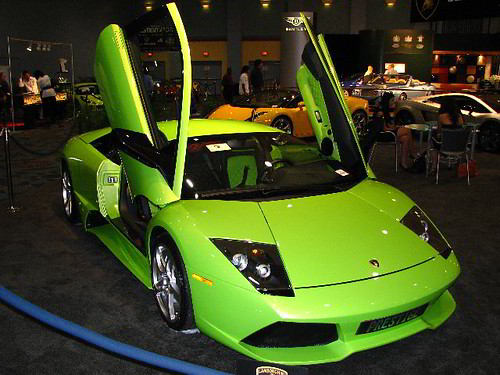Secondary market for Lithium batteries with grid storage applications will be a very important catalyst for mass adoption of electric cars. It will allow to drive the cost of the lithium batteries down faster. In this article we have another angle: utilities could actually to pay you to plug into the grid - they will use distributed storage system based on a number of Electric Cars plugged in as a grid stabiliser in this scenario.

Alan Boyle / msnbc.com |
A Toyota Scion converted to all-electric power is plugged into California's electrical
grid during a demonstration at the annual meeting of the American Association for
the Advancement of Science in San Diego.
|
Someday, someone will pay you to hook your car into the electrical grid. It's one of those almost-a-sure-thing business opportunities enabled by the expected rise of plug-in vehicles. But will the payoff be worth the cost? That's where the calculations get a little complicated.
Experts on the future of the electrical grid and plug-in electric cars came together this week in San Diego at the annual meeting of the American Association for the Advancement of Science to discuss their common interests.
The concept of moving power back and forth between a smarter grid and more capable electric cars, known as vehicle-to-grid or V2G, is a "perfect bridge technology" for two complementary energy frontiers, said Jasna Tomic, new-fuels project manager for Calstart, a nonprofit energy research center headquartered in California. It's a concept that utilities are willing to shell out money to support, said Ken Huber, senior technology and education principal at Pennsylvania-based PJM Interconnection.
PJM coordinates power transmission for a region that takes in all or part of 13 states and the District of Columbia. One of the big challenges for companies like PJM is to keep the load on the regional grids as stable as possible. Too much of a load is bad, potentially leading to brownouts. Too little of a load can also be bad, especially as electric utilities move toward renewable sources such as wind and solar energy.
To keep its regional grid stable, PJM needs to have battery storage capability equal to 1 percent of its peak load. Since PJM's peak is around 100,000 megawatts, "we have 1,000 megawatts moving up and down," Huber explained.
So here's where your future electric car enters the picture: PJM is currently paying battery providers somewhere around $25 to $35 per megawatt-hour to have that electrical storage available. If you have a plugged-in car just sitting idle, PJM would love to have a system that could take a little bit of the power out of your car battery during peak times, and send it back out to your battery during off-peak hours.
"It has a very, very high value to the grid," Huber said.
How much is it worth?
Exactly how much value? That's the point of a pilot project operated by a group called the
MAGIC Consortium. The consortium started small, connecting just a few cars from the University of Delaware's campus fleet. The cars were Toyota Scions that were converted into all-electric "eBoxes" using AC Propulsion's kit.
The conversion also required the addition of a power control box that could transmit and receive data about the battery's state as well as the electric company's power requirements over a secure Internet connection. After all, the last thing you want is to have somebody hack into your car.
Three or four cars are hardly worth developing a system for, but for the University of Delaware test, the AES power company served as an aggregator for battery capacity. The payment to the customer - in this case, the University of Delaware - was based on how much capacity the cars' batteries held (19 kilowatt-hours), and how long the car was plugged in (on average, 21.5 hours a day).
The payments typically amounted to $300 per month per car, said Willett Kempton, senior policy scientist at the University of Delaware's Center for Energy and Environmental Policy.
Not ready for prime time
If you consider merely the $500 cost of adding the control box and software, that's a good deal. But if you factor in the cost of converting the car into a plug-in vehicle - an expense that can range into
tens of thousands of dollars- you definitely wouldn't do it just for the power company's payout.
"Right now, because batteries are expensive, the value is less than the cost," Kempton acknowledged.
You'd have to consider other benefits - for example, the fact that you could charge up your eBox for a 150-mile trip for just a couple of dollars, which is less than the price for a gallon of gasoline.

AP file |
The Chevy Volt goes on display at the Washington Auto Show.
|
Although converted plug-ins such as AC Propulsion's eBox are available now, most people will probably wait to make their plug-in purchase until they get a look at mass-market vehicles such as the Chevy Volt (a gas-electric hybrid) and the Nissan Leaf (which is all-electric). Both those models should be available starting late this year.
It's too early to judge just how much impact plug-in cars will have, particularly when it comes to vehicle-to-grid technology. But if a million electric vehicles hit the streets in the next five years, as President Barack Obama has suggested, something will have to be done to accommodate that extra load on the grid, Huber said. That could take the form of demand-sensitive pricing for electricity - which would make V2G more attractive.
"I don't believe we're going to be in the situation we're in today for very much longer," Huber said.
Boosting the batteries
Better battery packs will be key to the success of plug-in vehicles, said Tony Posawatz, vehicle line director for the Chevy Volt. General Motors has developed a new breed of 16-kilowatt-hour batteries based on lithium-manganese chemistry - as well as a cooling and heating system to keep those batteries at a stable temperature.
"We call the battery the 'fifth passenger' sometimes, because we take such good care of it," Posawatz told me.
As more plug-ins are sold, more and more batteries will be available to store and eventually use the energy that's generated by solar and wind. "We're going to make this asset available to plug in all the time to collect the energy created by this green technology," Posawatz said.
GM is working on a number of initiatives for smart charging and automatic software upgrades, including technologies that take advantage of the automaker's OnStar service. But it will be a while before vehicle-to-grid technology is built into the Volt, Posawatz said. "Two-way energy transfer is several years out," he told me.
It's more likely that car owners will use their own "smarts," once cars like the Volt have been around for a while. Some might sign up for a V2G upgrade from the utility, like the system pioneered by the MAGIC Consortium. Others might install solar panels at home and use their plugged-in car as a storage device for home-brewed electricity.
In the long run, car owners might even save their old plug-in batteries to store more power at home. "We believe the battery will have a life outside the car," Posawatz said.
But pretty much everyone agrees that the most important milestone on the road to plug-in paradise will be cheaper batteries. Right now, the batteries for plug-in cars cost $1,000 or more per kilowatt-hour - which makes the plug-ins much more expensive than their petroleum-fueled counterparts. The battery cost is so significant that the National Research Council concluded it would take decades for the benefits of plug-ins to outweigh the costs.
"That's the biggest challenge," Posawatz acknowledged. "How can we quickly move down the cost curve and get the technological advances going? Certainly the automotive industry does not move as quickly as the telecommunications industry. ... Can we make that kind of progress on a shorter time scale?"
What do you think? Is there a plug-in payoff in your future, or are biofuels the way to go? Feel free to weigh in with your comments below.

















0 comments:
Post a Comment